Alumina Ceramics for Armor Protection via 3D Printing Using Different Monomers
Abstract
1. Introduction
2. Materials and Methods
2.1. Photosensitive Slurry
2.2. Three-Dimensional Printing and Sintering
2.3. Characterization and Testing of the Slurry and Ceramics
3. Results and Discussion
3.1. Properties of Resins and Slurries
3.2. Sintering Procedure
3.3. Microstructure of the Ceramics
4. Conclusions
- (1)
- The photosensitive slurries using DPGDA as a monomer with a solid loading of 56 vol.% displayed the optimal curing performance, with a low viscosity of 2910 mPa·s and a small volume shrinkage of 0.46% during 3D printing, and the photosensitive resin with monomers of DPGDA showed the lowest critical exposure energy of 27.5 mJ/cm2, suggesting easy curing to form the solid state. Each of the above properties is conducive to a good curing performance in 3D printing, making it a suitable formula for the 3D printing of ceramic materials.
- (2)
- In the 3D-printed sample using DPGDA as a monomer, microstructures with tiny interlayer cracks were exhibited in the green body, and the cracks disappeared completely after sintering due to particle re-arrangement and solid-state diffusion between different printing layers, resulting in a dense and uniform microstructure. In comparison, when TMPTA was employed as a monomer, the green body showed an anisotropic microstructure with serious interlayer gaps with widths of up to 40 μm, which was attributed to the difficulty in curing TMPTA with three functional groups. Furthermore, the sintering driving force was unable to remove the wide interlayer gaps, leading to an inhomogeneous microstructure with residual interlayer gaps and a porosity of 9.8%.
- (3)
- The different monomers had a further significant effect on the mechanical properties of alumina ceramics after sintering. The sample with monomers of TMPTA showed poor mechanical properties, attributed to the low relative density and serious interlayer gaps in the microstructure. In comparison, the dense uniform microstructure in the sample with DPGDA as a monomer contributed to its superior properties, with a relative density of 97.5 ± 0.5%, a Vickers hardness of 19.4 ± 0.8 GPa, a fracture toughness of 2.6 ± 0.27 MPa·m1/2, a bending strength of 690 ± 54 MPa, and a dynamic strength of 3.7 ± 0.6 GPa at a strain rate of 1200 s−1, comparable to the properties of commercial armor ceramics.
Author Contributions
Funding
Institutional Review Board Statement
Informed Consent Statement
Data Availability Statement
Conflicts of Interest
References
- Zhang, P.; Zhou, F.; Zhang, C.; Yan, Z.; Li, J.; Jin, H.; Zhang, H.; Lu, J. Charge trapping characteristics of alumina based ceramics. Ceram. Int. 2018, 44, 12112–12117. [Google Scholar] [CrossRef]
- Nötzel, D.; Hanemann, T. New feedstock system for fused filament fabrication of sintered alumina parts. Materials 2020, 13, 4461. [Google Scholar] [CrossRef] [PubMed]
- Obikawa, T.; Matsumura, T.; Shirakashi, T.; Usui, E. Wear characteristic of alumina coated and alumina ceramic tools. J. Mater. Process. Technol. 1997, 63, 211–216. [Google Scholar] [CrossRef]
- Wang, W.; Chen, J.; Sun, X.; Sun, G.; Liang, Y.; Bi, J. Influence of additives on microstructure and mechanical properties of alumina ceramics. Materials 2022, 15, 2956. [Google Scholar] [CrossRef] [PubMed]
- Tang, S.; Fu, L.; Gu, H.; Huang, A.; Yang, S.; Lv, R. Improved mechanical properties of alumina ceramics using plasma-assisted milling technique. Materials 2023, 16, 1128. [Google Scholar] [CrossRef] [PubMed]
- Golestani-fard, F.; Mazaheri, M.; Aminzare, M.; Ebadzadeh, T. Microstructural evolution of a commercial ultrafine alumina powder densified by different methods. J. Eur. Ceram. Soc. 2011, 31, 2593–2599. [Google Scholar] [CrossRef]
- Wang, L.; An, L.; Zhao, J.; Shimai, S.; Mao, X.; Zhang, J.; Liu, J.; Wang, S. High-strength porous alumina ceramics prepared from stable wet foams. J. Adv. Ceram. 2021, 10, 852–859. [Google Scholar] [CrossRef]
- Boldin, M.S.; Berendeev, N.N.; Melekhin, N.V.; Popov, A.A.; Nokhrin, A.V.; Chuvildeev, V.N. Review of ballistic performance of alumina: Comparison of alumina with silicon carbide and boron carbid. Ceram. Int. 2021, 47, 25201–25213. [Google Scholar] [CrossRef]
- Eugen, E.; Medvedovsk, I. Ballistic performance of armour ceramics: Influence of design and structure, Part 1. Ceram. Int. 2010, 36, 2103–2115. [Google Scholar]
- Bilal, A.; Jahan, M.P.; Talamona, D.; Perveen, A. Electro-discharge machining of ceramics: A review. Micromachines 2018, 10, 10. [Google Scholar] [CrossRef]
- Heng, L.; Kim, J.S.; Song, J.H.; Mun, S.D. A review on surface finishing techniques for difficult-to-machine ceramics by non-conventional finishing processes. Materials 2022, 15, 1227. [Google Scholar] [CrossRef] [PubMed]
- Diaz, O.G.; Luna, G.G.; Liao, Z. The new challenges of machining ceramic matrix composites (CMC): Review of surface integrity. Int. J. Mach. Tools Manuf. 2019, 139, 24–36. [Google Scholar] [CrossRef]
- Eckel, Z.C.; Zhou, C.; Martin, J.H.; Jacobsen, A.J.; Carter, W.B.; Schaedler, T.A. Additive manufacturing of polymer-derived ceramics. Science 2016, 351, 58–62. [Google Scholar] [CrossRef] [PubMed]
- Zocca, A.; Colombo, P.; Gomes, C.M.; Günster, J. Additive manufacturing of ceramics: Issues, potentialities, and opportunities. J. Am. Ceram. Soc. 2015, 98, 1983–2001. [Google Scholar] [CrossRef]
- Chen, Z.; Li, Z.; Li, J.; Liu, C.; Lao, C.; Fu, Y.; Liu, C.; Li, Y.; Wang, P.; He, Y. 3D printing of ceramics: A review. J. Eur. Ceram. Soc. 2019, 39, 661–687. [Google Scholar] [CrossRef]
- Li, H.; Liu, Y.; Liu, Y.; Zeng, Q.; Hu, K.; Lu, Z.; Liang, J.; Li, J. Influence of debinding holding time on mechanical properties of 3D-printed alumina ceramic cores. Ceram. Int. 2021, 47, 4884–4894. [Google Scholar] [CrossRef]
- Li, Q.; An, X.; Liang, J.; Liu, Y.; Hu, K.; Lu, Z.; Yue, X.; Li, J.; Zhou, Y.; Sun, X. Balancing flexural strength and porosity in DLP-3D printing Al2O3 cores for hollow turbine blades. J. Mater. Sci. Technol. 2022, 104, 19–32. [Google Scholar] [CrossRef]
- Wang, S.; Peng, L.; Song, C.; Wang, C. Digital light processing additive manufacturing of thin dental porcelain veneers. J. Eur. Ceram. Soc. 2023, 43, 1161–1167. [Google Scholar] [CrossRef]
- Li, H.; Hu, K.; Liu, Y.; Lu, Z.; Liang, J. Improved mechanical properties of silica ceramic cores prepared by 3D printing and sintering processes. Scr. Mater. 2021, 194, 113665. [Google Scholar] [CrossRef]
- Zheng, W.; Wu, J.-M.; Chen, S.; Yu, K.-B.; Hua, S.-B.; Li, C.-H.; Zhang, J.-X.; Shi, Y.-S. Fabrication of high-performance silica-based ceramic cores through selective laser sintering combined with vacuum infiltration. Addit. Manuf. 2021, 48, 102396. [Google Scholar] [CrossRef]
- Ma, C.; He, C.; Wang, W.; Yao, X.; Yan, L.; Hou, F.; Liu, J.; Guo, A. Metal-doped polymer-derived SiOC composites with inorganic metal salt as the metal source by digital light processing 3D printing. Virtual Phys. Prototyp. 2020, 15, 294–306. [Google Scholar] [CrossRef]
- Fan, J.; Xu, X.; Niu, S.; Zhou, Y.; Li, X.; Guo, Y.; Luo, Y. Anisotropy management on microstructure and mechanical property in 3D printing of silica-based ceramic cores. J. Eur. Ceram. Soc. 2022, 42, 4388–4395. [Google Scholar] [CrossRef]
- Qian, C.; Hu, K.; Lu, Z.; Li, P. Volume shrinkage and conversion rate of Al2O3 ceramic stereolithography suspension polymerised by ultraviolet light. Mater. Chem. Phys. 2021, 267, 124661. [Google Scholar] [CrossRef]
- Niu, S.; Luo, Y.; Li, X.; Chen, Y.; Cheng, Y.; Dai, S.; Zhang, Q.; Li, H.; Xu, X. 3D printing of silica-based ceramic cores reinforced by alumina with controlled anisotropy. J. Alloys Compd. 2022, 922, 166325. [Google Scholar] [CrossRef]
- Kim, I.; Kim, S.; Andreu, A.; Kim, J.-H.; Yoon, Y.-J. Influence of dispersant concentration toward enhancing printing precision and surface quality of vat photopolymerization 3D printed ceramics. Addit. Manuf. 2022, 52, 102659. [Google Scholar] [CrossRef]
- Xu, X.; Zhou, S.; Wu, J.; Zhang, C.; Liu, X. Inter-particle interactions of alumina powders in UV-curable suspensions for DLP stereolithography and its effect on rheology, solid loading, and self-leveling behavior. J. Eur. Ceram. Soc. 2021, 41, 2763–2774. [Google Scholar] [CrossRef]
- Mu, Y.; Chen, J.; An, X.; Liang, J.; Li, J.; Zhou, Y.; Sun, X. Effect of synergism of solid loading and sintering temperature on microstructural evolution and mechanical properties of 60 vol% high solid loading ceramic core obtained through stereolithography 3D printing. J. Eur. Ceram. Soc. 2023, 43, 661–675. [Google Scholar] [CrossRef]
- Song, S.Y.; Park, M.S.; Lee, D.; Lee, J.W.; Yun, J.S. Optimization and characterization of high-viscosity ZrO2 ceramic nanocomposite resins for supportless stereolithography. Mater. Des. 2019, 180, 107960. [Google Scholar] [CrossRef]
- Ozkan, B.; Sameni, F.; Bianchi, F.; Zarezadeh, H.; Karmel, S.; Engstrøm, D.S.; Sabet, E. 3D printing ceramic cores for investment casting of turbine blades, using LCD screen printers: The mixture design and characterisation. J. Eur. Ceram. Soc. 2022, 42, 658–671. [Google Scholar] [CrossRef]
- An, X.; Mu, Y.; Chen, J.; Liang, J.; Li, J.; Zhou, Y.; Sun, X. Compositional optimization of high-solid-loading ceramic cores via 3D printing. Addit. Manuf. 2022, 58, 103054. [Google Scholar] [CrossRef]
- Li, H.; Liu, Y.; Liu, Y.; Zeng, Q.; Wang, J.; Hu, K.; Lu, Z.; Liang, J. Evolution of the microstructure and mechanical properties of stereolithography formed alumina cores sintered in vacuum. J. Eur. Ceram. Soc. 2020, 40, 4825–4836. [Google Scholar] [CrossRef]
- Gentry, S.P.; Halloran, J.W. Depth and width of cured lines in photopolymerizable ceramic suspensions. J. Eur. Ceram. Soc. 2013, 33, 1981–1988. [Google Scholar] [CrossRef]
- Zakeri, S.; Vippola, M.; Levänen, E. A comprehensive review of the photopolymerization of ceramic resins used in stereolithography. Addit. Manuf. 2020, 35, 101177. [Google Scholar] [CrossRef]
- Mendelson, M.I. Average grain size in polycrystalline ceramics. J. Am. Ceram. Soc. 1969, 52, 443–446. [Google Scholar] [CrossRef]
- Standard Test Methods for Determination of Water Absorption and Associated Properties by Vacuum Method for Pressed Ceramic Tiles and Glass Tiles and Boil Method for Extruded Ceramic Tiles and Non-tile Fired Ceramic Whiteware Products, ASTM C373-18. Available online: https://www.astm.org/c0373-18.html (accessed on 20 May 2024).
- Qian, C.; Hu, K.; Li, J.; Li, P.; Lu, Z. The effect of light scattering in stereolithography ceramic manufacturing. J. Eur. Ceram. Soc. 2021, 41, 7141–7154. [Google Scholar] [CrossRef]
- Wang, X.; Zhou, Y.; Zhou, L.; Xu, X.; Niu, S.; Li, X.; Chen, X. Microstructure and properties evolution of silicon-based ceramic cores fabricated by 3D printing with stair-stepping effect control. J. Eur. Ceram. Soc. 2021, 41, 4650–4657. [Google Scholar] [CrossRef]
- Li, Q.; Hou, W.; Liang, J.; Zhang, C.; Li, J.; Zhou, Y.; Sun, X. Controlling the anisotropy behaviour of 3D printed ceramic cores: From intralayer particle distribution to interlayer pore evolution. Addit. Manuf. 2022, 58, 103055. [Google Scholar] [CrossRef]
- Li, H.; Liu, Y.; Colombo, P.; Li, W.; Liu, Y.; Hu, K.; Lu, Z. The influence of sintering procedure and porosity on the properties of 3D printed alumina ceramic cores. Ceram. Int. 2021, 47, 27668–27676. [Google Scholar] [CrossRef]
- Paliwal, B.; Ramesh, K.T.; Mccauley, J.W. Direct Observation of the Dynamic Compressive Failure of a Transparent Polycrystalline Ceramic (AlON). J. Am. Ceram. Soc. 2006, 89, 2128–2133. [Google Scholar] [CrossRef]
- Subhash, G.; Maiti, G.; Geubelle, P.H. Recent Advances in Dynamic Indentation Fracture, Impact Damage and Fragmentation of Ceramics. J. Am. Ceram. Soc. 2008, 91, 2777–2791. [Google Scholar] [CrossRef]
- Ravichandran, G.; Subhash, G. A micromechanical model for high strain rate behavior of ceramics. Int. J. Solids Struct. 1995, 32, 2627–2646. [Google Scholar] [CrossRef]
- Zhang, D.; Yu, R.; Feng, X.; Guo, X.; Yang, Y.; Xu, X. Enhanced Mechanical Properties of Al2O3 Nanoceramics via Low Temperature Spark Plasma Sintering of Amorphous Powders. Materials 2023, 16, 5652. [Google Scholar] [CrossRef] [PubMed]
- Arab, A.; Ahmad, Z.A.; Ahmad, R. Effects of yttria stabilized zirconia (3Y-TZP) percentages on the ZTA dynamic mechanical properties. Int. J. Refract. Met. Hard Mater. 2015, 50, 157–162. [Google Scholar] [CrossRef]

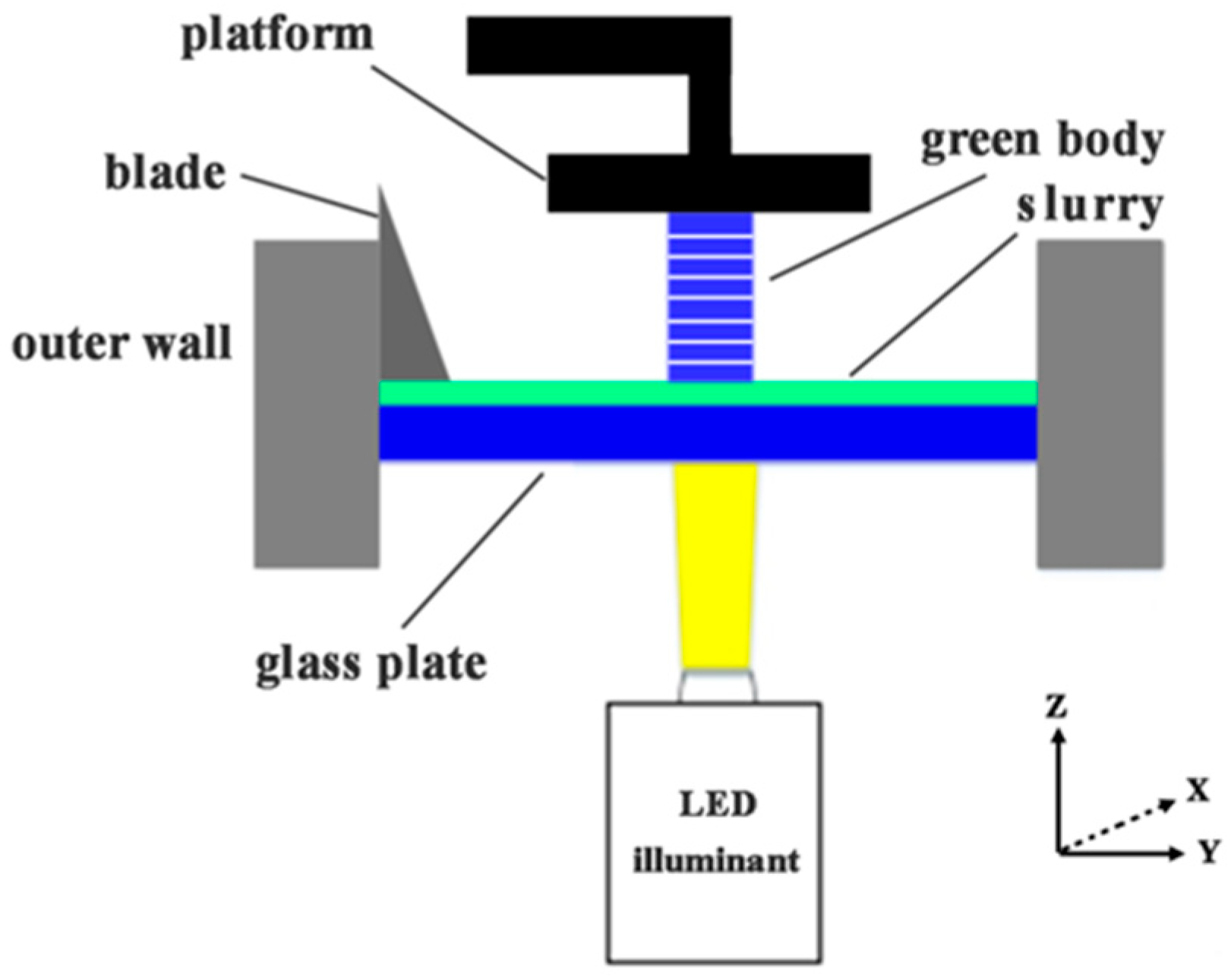
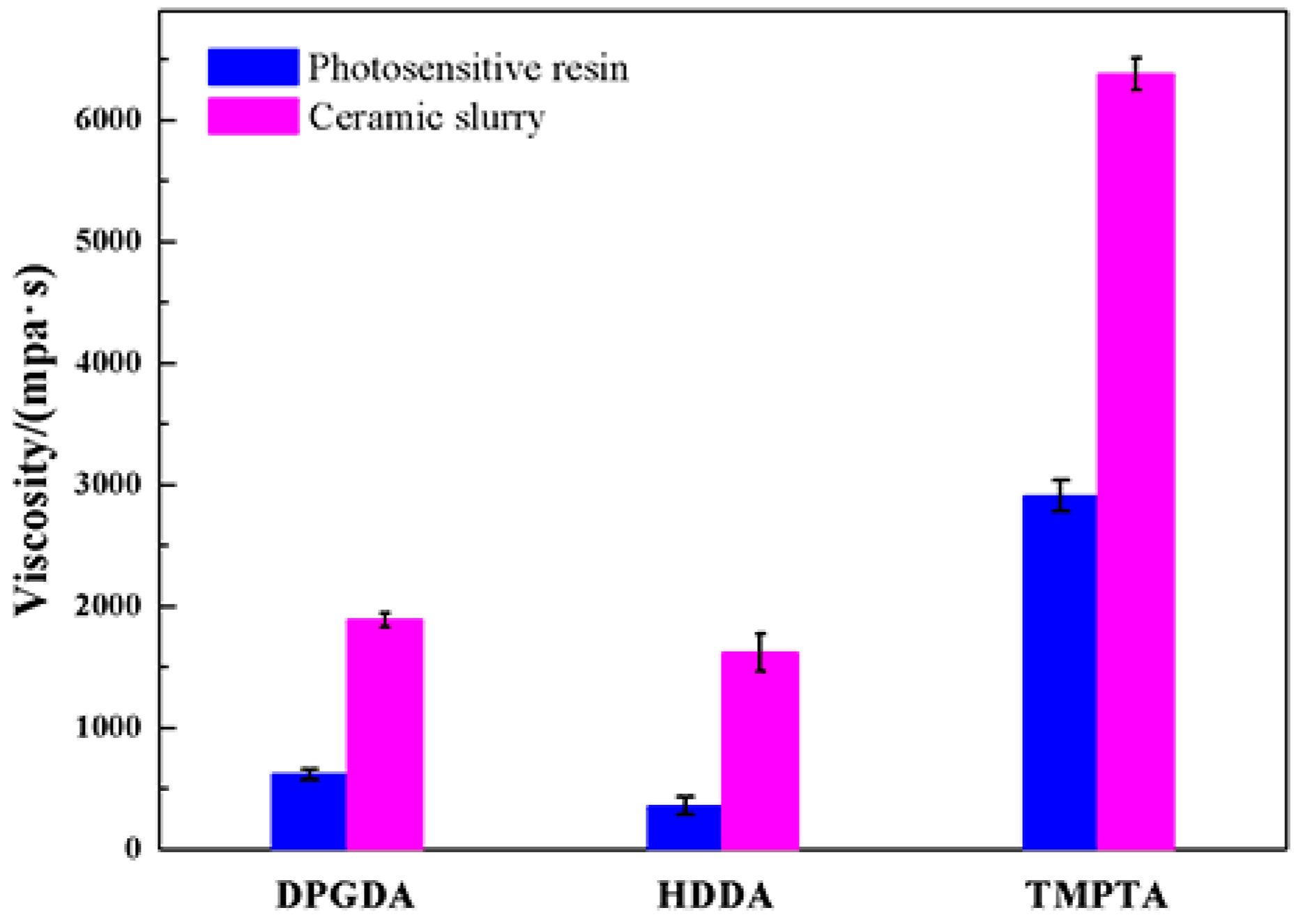

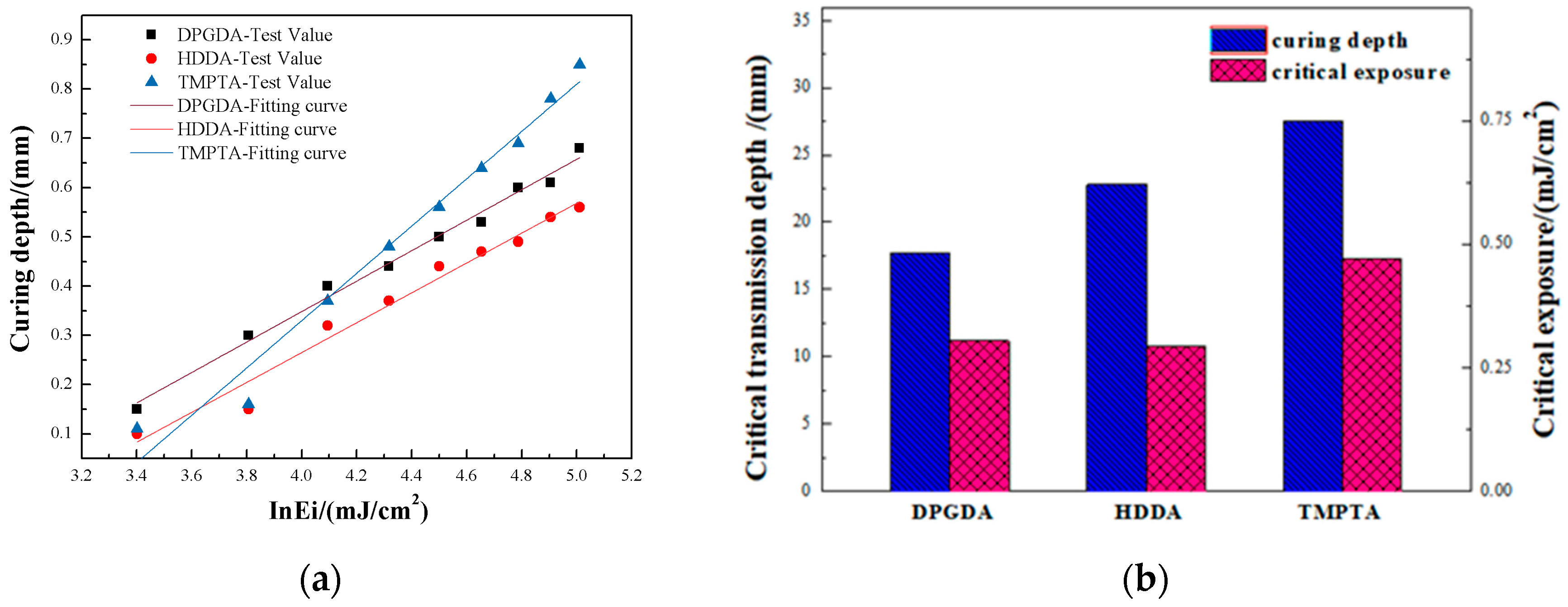
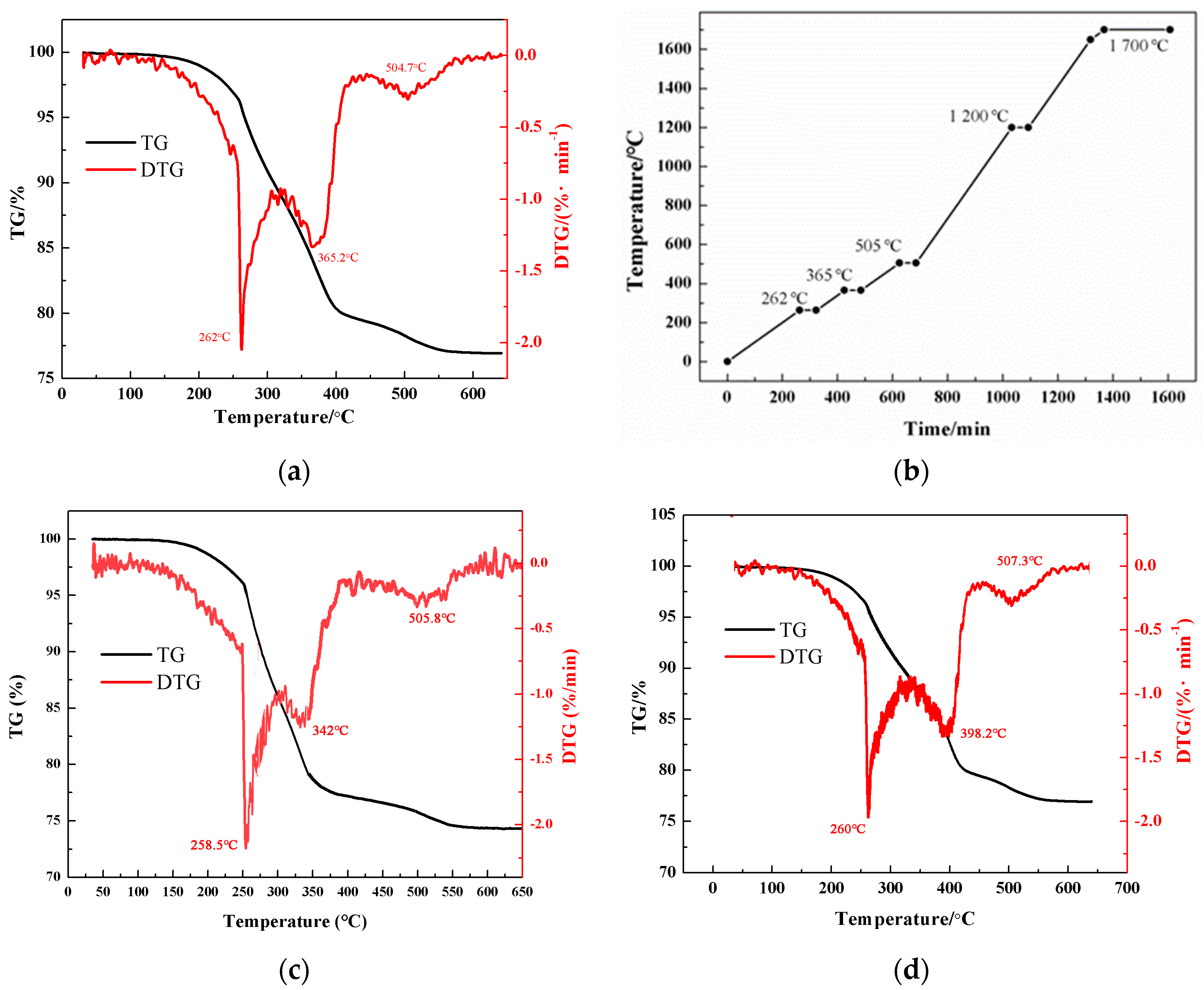


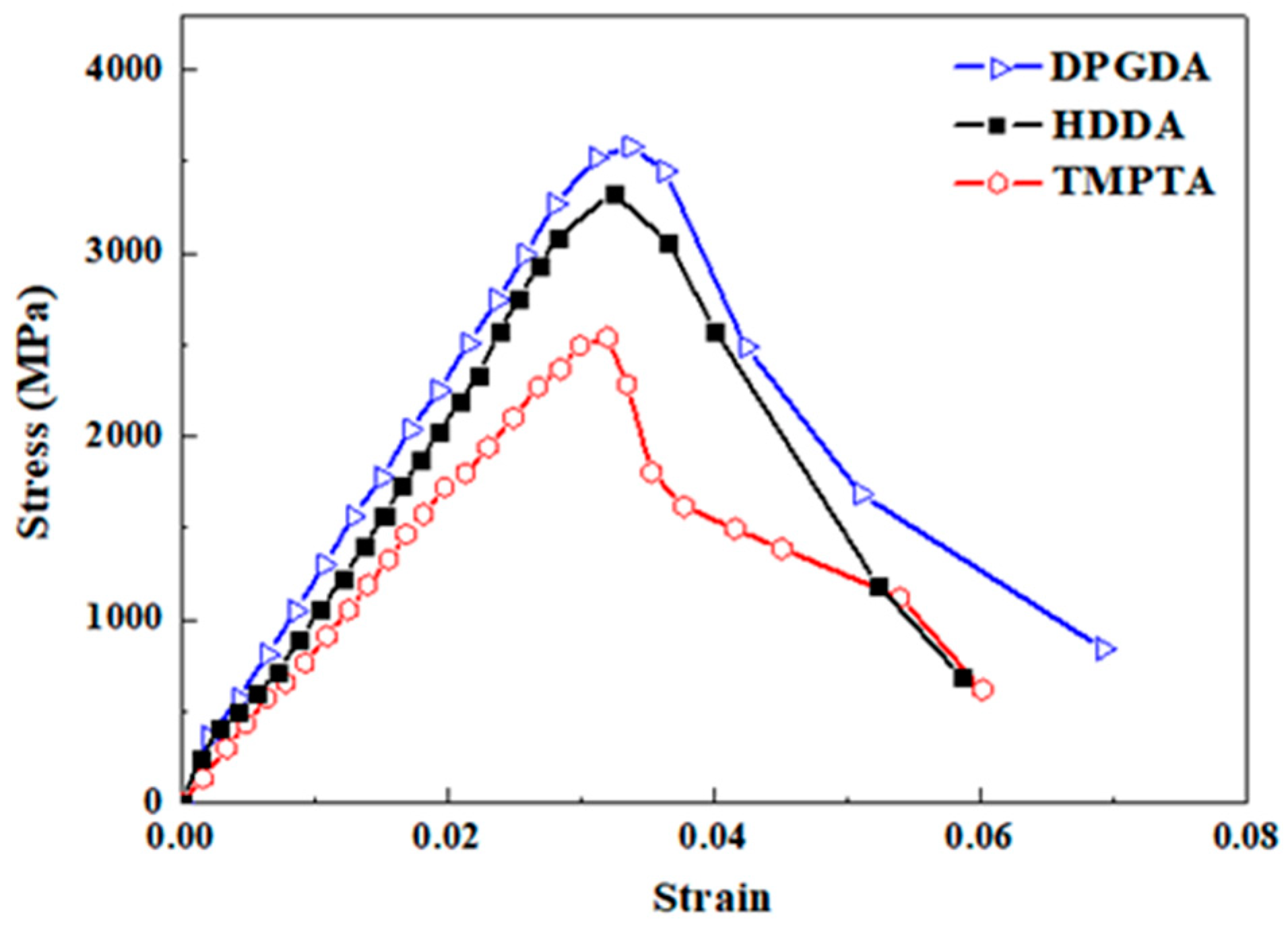
| Ei | 30 | 45 | 60 | 75 | 90 | 105 | 120 | 135 | 150 | ||
|---|---|---|---|---|---|---|---|---|---|---|---|
| Cp | |||||||||||
| Monomer | |||||||||||
| DPGDA | 0.15 | 0.3 | 0.4 | 0.44 | 0.5 | 0.53 | 0.6 | 0.61 | 0.68 | ||
| HDDA | 0.1 | 0.15 | 0.31 | 0.37 | 0.44 | 0.47 | 0.49 | 0.54 | 0.56 | ||
| TMPTA | 0.11 | 0.16 | 0.37 | 0.48 | 0.56 | 0.69 | 0.69 | 0.78 | 0.85 | ||
| Monomer | Relative Density (%) | Volume Shrink Age (%) | Grain Size (μm) | HV (GPa) | KIC (MPa·m1/2) | σ (MPa) |
|---|---|---|---|---|---|---|
| DPGDA | 97.5 ± 0.5 | 42.5 ± 0.8 | 15.9 ± 2.2 | 19.4 ± 0.8 | 2.6 ± 0.27 | 690 ± 54 |
| HDDA | 96.7 ± 0.6 | 42.0 ± 1.0 | 15.7 ± 4.7 | 18.8 ± 1.1 | 2.4 ± 0.35 | 660 ± 76 |
| TMPTA | 90.2 ± 1.3 | 37.8 ± 1.4 | 16.9 ± 6.4 | 15.5 ± 2.1 | 1.9 ± 0.52 | 510 ± 76 |
Disclaimer/Publisher’s Note: The statements, opinions and data contained in all publications are solely those of the individual author(s) and contributor(s) and not of MDPI and/or the editor(s). MDPI and/or the editor(s) disclaim responsibility for any injury to people or property resulting from any ideas, methods, instructions or products referred to in the content. |
© 2024 by the authors. Licensee MDPI, Basel, Switzerland. This article is an open access article distributed under the terms and conditions of the Creative Commons Attribution (CC BY) license (https://creativecommons.org/licenses/by/4.0/).
Share and Cite
Zhang, D.; Liang, Z.; Chen, X.; Pang, C.; Guo, X.; Xu, X. Alumina Ceramics for Armor Protection via 3D Printing Using Different Monomers. Materials 2024, 17, 2506. https://doi.org/10.3390/ma17112506
Zhang D, Liang Z, Chen X, Pang C, Guo X, Xu X. Alumina Ceramics for Armor Protection via 3D Printing Using Different Monomers. Materials. 2024; 17(11):2506. https://doi.org/10.3390/ma17112506
Chicago/Turabian StyleZhang, Dongjiang, Zhengang Liang, Xin Chen, Chunxu Pang, Xuncheng Guo, and Xiqing Xu. 2024. "Alumina Ceramics for Armor Protection via 3D Printing Using Different Monomers" Materials 17, no. 11: 2506. https://doi.org/10.3390/ma17112506
APA StyleZhang, D., Liang, Z., Chen, X., Pang, C., Guo, X., & Xu, X. (2024). Alumina Ceramics for Armor Protection via 3D Printing Using Different Monomers. Materials, 17(11), 2506. https://doi.org/10.3390/ma17112506





